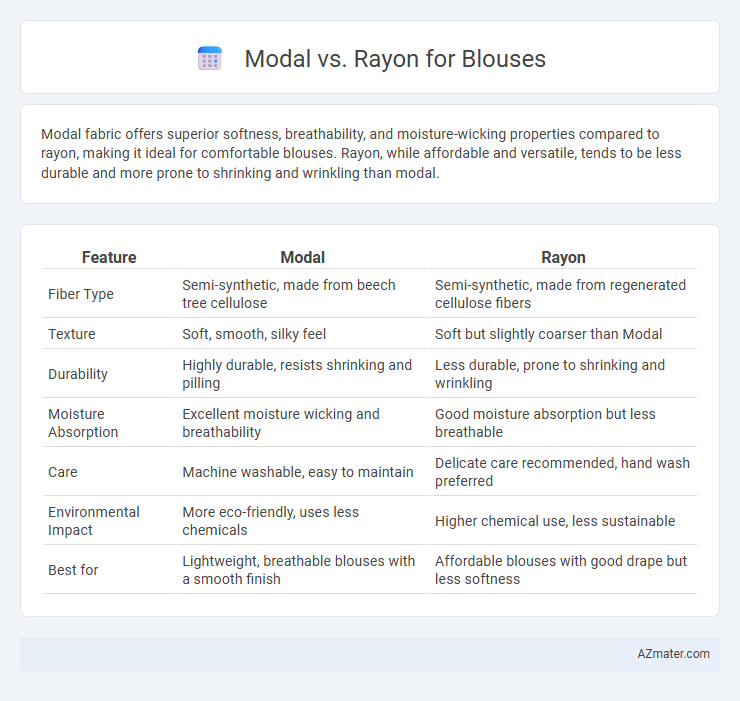Modal fabric offers superior softness, breathability, and moisture-wicking properties compared to rayon, making it ideal for comfortable blouses. Rayon, while affordable and versatile, tends to be less durable and more prone to shrinking and wrinkling than modal.
Table of Comparison
| Feature | Modal | Rayon |
|---|---|---|
| Fiber Type | Semi-synthetic, made from beech tree cellulose | Semi-synthetic, made from regenerated cellulose fibers |
| Texture | Soft, smooth, silky feel | Soft but slightly coarser than Modal |
| Durability | Highly durable, resists shrinking and pilling | Less durable, prone to shrinking and wrinkling |
| Moisture Absorption | Excellent moisture wicking and breathability | Good moisture absorption but less breathable |
| Care | Machine washable, easy to maintain | Delicate care recommended, hand wash preferred |
| Environmental Impact | More eco-friendly, uses less chemicals | Higher chemical use, less sustainable |
| Best for | Lightweight, breathable blouses with a smooth finish | Affordable blouses with good drape but less softness |
Introduction to Modal and Rayon
Modal, a type of semi-synthetic cellulose fiber made from beech tree pulp, is known for its breathability, softness, and excellent moisture-wicking properties, making it a popular choice for blouses designed for comfort and durability. Rayon, derived from regenerated cellulose fibers primarily sourced from wood pulp, offers a luxurious feel with good drape and vibrant color absorption, ideal for blouses that prioritize a flowing silhouette and rich hues. Both Modal and Rayon contribute unique qualities to blouses, with Modal excelling in softness and moisture management, while Rayon stands out for its silky texture and vibrant appearance.
What is Modal Fabric?
Modal fabric is a type of semi-synthetic cellulose fiber made from beech tree pulp, known for its exceptional softness and breathability, making it ideal for blouses that require a smooth, silky feel. It excels in moisture-wicking and durability, retaining color and shape even after multiple washes, which enhances the blouse's longevity and appearance. Modal's eco-friendly production process and resistance to shrinking or pilling distinguish it as a premium fabric choice compared to rayon.
What is Rayon Fabric?
Rayon fabric is a semi-synthetic fiber made from chemically processed cellulose derived from wood pulp, offering a soft and breathable feel ideal for blouses. It drapes well, providing a lightweight and comfortable fit suitable for warm weather. Compared to Modal, Rayon tends to be more affordable but may be less durable and prone to shrinking or wrinkling.
Texture and Feel: Modal vs Rayon
Modal fabric offers a smoother, silkier texture compared to rayon, providing a luxurious feel against the skin. Rayon tends to be softer and more absorbent but can feel slightly heavier and less silky than modal. Both fabrics drape well, but modal's superior smoothness and breathability make it a preferred choice for comfortable, high-quality blouses.
Breathability and Comfort Comparison
Modal fabric offers superior breathability compared to rayon due to its higher moisture-wicking properties, making it ideal for blouses worn in warm climates. Rayon, while soft and smooth, tends to retain more moisture, which can reduce comfort during prolonged wear. Both fabrics provide a lightweight feel, but modal's enhanced airflow ensures better ventilation and comfort throughout the day.
Durability: Which Lasts Longer?
Modal fabric exhibits higher durability than rayon due to its stronger fiber structure and resistance to pilling, making it ideal for long-lasting blouses. Rayon tends to weaken with repeated washing and can lose its shape quicker, reducing the lifespan of garments. Therefore, blouses made from modal maintain their integrity and vibrant appearance significantly longer than those crafted from rayon.
Sustainability and Eco-Friendliness
Modal fabric, derived from beech tree pulp, offers superior sustainability due to its biodegradable nature and efficient water usage during production compared to traditional rayon, which often relies on chemically intensive processes from wood pulp. Rayon, while versatile and affordable, has a larger environmental footprint because of chemical solvents used in its manufacture and less eco-friendly harvesting practices. Choosing modal for blouses supports eco-conscious fashion by reducing toxic waste and promoting renewable resource utilization.
Care and Maintenance Tips
Modal fabric offers better resistance to shrinking and fading when washed in cold water, making it easier to maintain for blouses with its smooth texture and durability. Rayon requires gentle care, such as hand washing or using a delicate cycle with cold water, to prevent fabric weakening and avoid wrinkling. Both materials benefit from air drying and low-temperature ironing to preserve the blouse's shape and softness over time.
Best Use Cases for Blouses
Modal fabric offers exceptional softness and moisture-wicking properties, making it ideal for lightweight, breathable blouses suited for warm weather or active wear. Rayon provides a smooth, silky texture with excellent drape, perfect for elegant, flowy blouses intended for formal occasions or office wear. Choosing between Modal and Rayon depends on the desired comfort, durability, and style, with Modal favored for casual comfort and Rayon preferred for sophisticated aesthetics.
Conclusion: Which is Better for Blouses?
Modal fabric offers superior softness, durability, and moisture-wicking properties, making it an excellent choice for blouses that prioritize comfort and longevity. Rayon, while breathable and lightweight, tends to be less durable and may wrinkle more easily, requiring careful maintenance. For blouses, modal stands out as the better fabric due to its enhanced resilience and luxurious feel.

Infographic: Modal vs Rayon for Blouse
 azmater.com
azmater.com